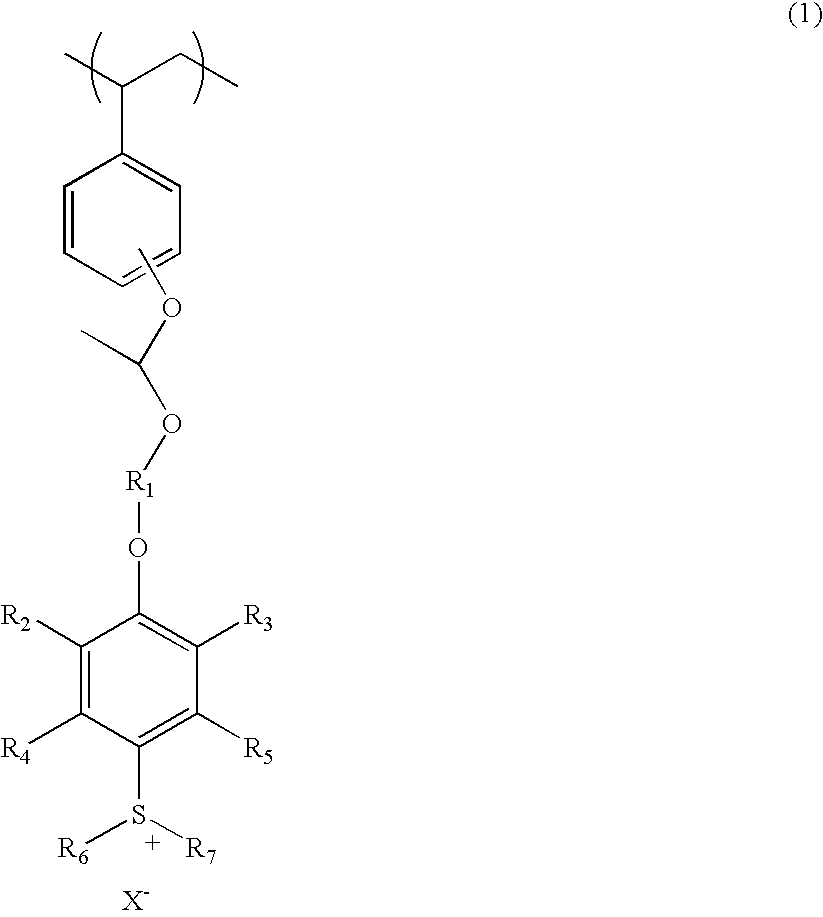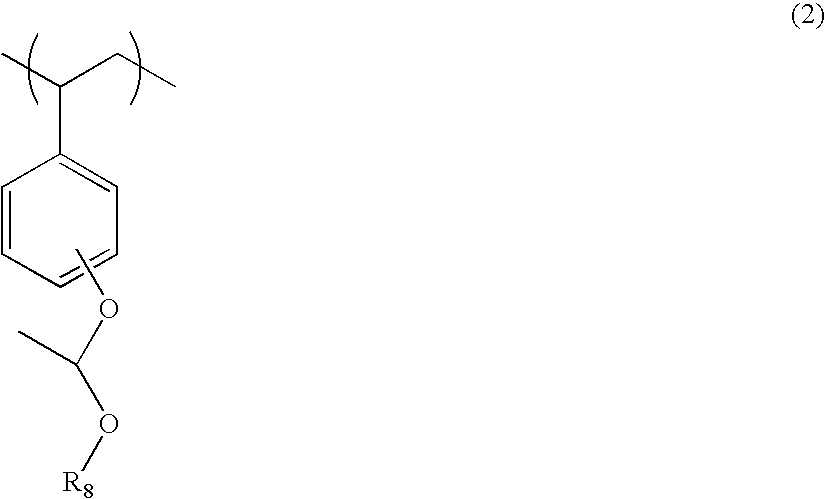Photosensitive resin, and photosensitive composition
- Summary
- Abstract
- Description
- Claims
- Application Information
AI Technical Summary
Benefits of technology
Problems solved by technology
Method used
Image
Examples
synthesis example 1
Synthesis of the Compound Represented by the Following Formula (4-vinyloxyethoxyphenyldiphenylsulfonium perfluorobutanesulfonate)
[0053]
[0054]4-Hydroxyphenyldiphenylsulfonium perfluorobutanesulfonate (52.2 g), potassium carbonate (18.0 g), and N,N,N′,N′-tetramethylethylenediamine (1.05 g) were dissolved in dimethyl sulfoxide (26.1 g). Subsequently, chloroethyl vinyl ether (13.9 g) was added to the resultant solution, followed by heating to 80° C. and stirring for 15 hours. The resultant reaction mixture was cooled to 30° C. or lower. After removal of solid matter through filtration, water (100 g) was added to the filtrate, and the aqueous layer was washed thrice with hexane (100 g). Dichloromethane (209 g) and water (260 g) were added to the washed aqueous layer, followed by stirring for extraction of a target substance into the dichloromethane layer. The organic layer was repeatedly washed with distilled water until the pH of the separated aqueous layer became 7. The solvent was rem...
synthesis example 2
Synthesis of the Compound Represented by the Following Formula (4-vinyloxyethoxy-3,5-dimethylphenyldi(4-t-butylphenyl)sulfonium perfluorobutanesulfonate
[0056]
[0057]4-Hydroxy-3,5-dimethylphenyldi(4-t-butylphenyl)sulfonium perfluorobutanesulfonate (28.6 g), potassium carbonate (8.10 g), and N,N,N′,N′-tetramethylethylenediamine (0.46 g) were dissolved in dimethyl sulfoxide (142 g). Subsequently, chloroethyl vinyl ether (6.08 g) was added to the resultant solution, followed by heating to 80° C. and stirring for 19 hours. The resultant reaction mixture was cooled to 30° C. or lower. After removal of solid matter through filtration, water (20.9 g) was added to the filtrate, and the aqueous layer was washed thrice with hexane (85.1 g). Dichloromethane (226 g) and water (141 g) were added to the washed aqueous layer, followed by stirring for extraction of a target substance into the dichloromethane layer. The organic layer was repeatedly washed with distilled water until the pH of the sepa...
synthesis example 3
Synthesis of the Compound Represented by the Following Formula (4-vinyloxyoctoxyphenyldiphenylsulfonium perfluorobutanesulfonate)
[0059]
[0060]8-Chloro-1-octanol (1.23 g), sodium carbonate (0.47 g), di-μ-chlorobis[η-cyclooctadieneiridium(I)] (0.47 g), and vinyl acetate (1.31 g) were added to toluene (6.15 g), and the resultant mixture was stirred at 100° C. for four hours. After cooling of the mixture to room temperature, the solvent was removed through evaporation. The resultant product was purified through column chromatography by use of a solvent mixture of hexane and dichloromethane (2:1 by volume), to thereby yield 1.16 g of 8-chlorooctyl vinyl ether as a colorless, transparent liquid.
[0061]4-Hydroxyphenyldiphenylsulfonium perfluorobutanesulfonate (2.67 g), potassium carbonate (0.78 g), and N,N,N′,N′-tetramethylethylenediamine (0.05 g) were dissolved in dimethyl sulfoxide (13.3 g). Subsequently, 8-chlorooctyl vinyl ether (1.05 g) was added to the resultant solution, followed by h...
PUM
| Property | Measurement | Unit |
|---|---|---|
| Photosensitivity | aaaaa | aaaaa |
| Compatibility | aaaaa | aaaaa |
Abstract
Description
Claims
Application Information
 Login to View More
Login to View More - R&D
- Intellectual Property
- Life Sciences
- Materials
- Tech Scout
- Unparalleled Data Quality
- Higher Quality Content
- 60% Fewer Hallucinations
Browse by: Latest US Patents, China's latest patents, Technical Efficacy Thesaurus, Application Domain, Technology Topic, Popular Technical Reports.
© 2025 PatSnap. All rights reserved.Legal|Privacy policy|Modern Slavery Act Transparency Statement|Sitemap|About US| Contact US: help@patsnap.com



